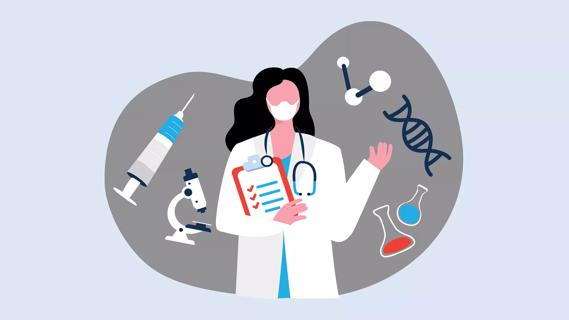Advertisement
PFAS chemicals may make life easier — but they aren’t always so easy on the human body

The idea of “forever” is exciting when you’re talking about diamonds or laser hair removal. But it’s alarming when experts explain how long it takes our bodies to break down harmful “forever” chemicals known as PFAS.
Advertisement
Cleveland Clinic is a non-profit academic medical center. Advertising on our site helps support our mission. We do not endorse non-Cleveland Clinic products or services. Policy
PFAS (per- and polyfluoroalkyl substances) are endocrine-disrupting chemicals (EDCs). They’re present in countless items you use every day, ranging from clothes and nonstick cookware to upholstery.
“EDCs are everywhere, and we’re being exposed to them constantly through what we eat, breathe and touch,” says endocrinologist David Shewmon, MD. “Over time, that exposure can cause problems in our bodies.”
That’s because small but repeated exposures to PFAS can build up inside you. Eventually, they can interfere with your hormones, affecting everything from mood and sleep to blood pressure, metabolism and reproduction.
So, how concerned should you be about contact with PFAS? Let’s learn more with Dr. Shewmon.
PFAS chemicals are a group of more than 9,000 compounds introduced by manufacturers in the 1940s. They’re manufactured and engineered to be strong, with a durable carbon-fluorine chemical bond.
Like many other industrial developments, PFAS chemicals were created with good intentions — to keep people safe, offer convenience and spur economic growth.
PFAS chemicals help products resist heat, oil, stains, grease and water. Americans interact with PFAS chemicals in everyday products, including:
Advertisement
Food packaging also used to be a major source of PFAS exposure in the U.S. Manufacturers often used them in chemical treatments designed to make paper and cardboard more water- and grease-proof — think fast food wrappers and microwave popcorn bags. More on that in a bit.
Forever chemicals escape from manufacturing facilities and consumer products into the environment. As more and more PFAS chemicals circulate and remain in the environment, our exposure to them increases.
Today, nearly all Americans have a detectable level of PFAS in their blood.
You’re exposed to PFAS when you:
Remember when we said that food wrappers used to be a major source of U.S. PFAS exposure? According to the U.S. Food and Drug Administration (FDA), PFAS were so common in food packaging that they were the primary source of (authorized) dietary exposure to PFAS.
In February 2024, the FDA announced that companies would be voluntarily phasing out food packaging treated with PFAS. The agency has allowed manufacturers to keep using the packaging supplies until they run out, or until August 2025 — whichever comes first. But they claim that “most of the companies … exited the market prior to their original phase-out date.”
All this to say that, while people living in the U.S. can’t be certain that all food wrappers they interact with are PFAS-free, the overall risk of dietary exposure is far lower than it used to be.
Researchers have only studied a handful of PFAS thoroughly. The U.S. Environmental Protection Agency (EPA) recently declared the two most-studied types — perfluorooctanoic acid (PFOA) and perfluorooctane sulfonate (PFOS) — to be dangerous substances.
American companies no longer manufacture PFOA and PFOS chemicals, but they continue to exist in the environment. Companies also still produce other PFAS chemicals.
Collected data suggests forever chemicals can cause harmful health effects. But how environmental toxins impact your health varies depending on:
“Nothing in medicine ever happens by itself, and the effects of EDCs are often the result of multiple exposures to several of these chemicals over time,” Dr. Shewmon says. “We know exposure to these chemicals is not the only reason you develop a chronic disease — but it can be a contributing factor over time.”
Repeated or high exposure to PFAS chemicals can cause them to build up in your blood. That may lead to health issues like:
Researchers studying the effects of eight different PFAS chemicals found changes to thyroid hormone levels, including thyroid-stimulating hormone (TSH) and thyroxine — the main hormone released by your thyroid.
When thyroid hormone levels change, it can cause body functions to either speed up (hyperthyroidism) or slow down (hypothyroidism).
Exposure to PFAS can affect children even before birth. Research has shown a link between prenatal (during pregnancy) exposure to PFAS and:
Other developmental concerns in children exposed to PFAS include:
Advertisement
The National Cancer Institute reports possible links between PFAS exposure and an increased risk of:
PFAS can impact your body’s immune function and ability to fight off disease.
According to a National Toxicology Program review, studies show that exposure to PFOA and PFOS may prevent your body from effectively responding to an infection. Research also finds that a child’s exposure to PFAS may reduce their immune system’s response to vaccines.
PFAS chemicals also present reproductive challenges, as studies show that high exposure can cause reduced semen quality and sperm count. And some studies link exposure to PFAS with difficulty getting pregnant.
Advertisement
During pregnancy, PFAS exposure may cause pregnancy-induced hypertension (preeclampsia).
The health effects of PFAS typically occur slowly and subtly over time and with repeated exposure.
But exposure may be high for people with certain jobs (firefighters and military personnel) and those living in certain locations (near a PFAS manufacturing plant or contaminated water supply). Those groups may see more harmful health effects.
If you don’t have those jobs or live in those areas, exposure to PFAS chemicals can be more moderate — especially if you recognize and avoid them when possible. As your exposure to forever chemicals decreases, so will the levels of PFAS in your body.
Some simple ways to reduce your exposure to PFAS include:
“We’re not trying to make you anxious about forever chemicals,” Dr. Shewmon reassures. “We just want to make you aware that EDCs exist and encourage you to pay more attention to the products you buy and consume.”
Advertisement
Learn more about our editorial process.
Advertisement

Life coaches can be great sounding boards, mentors and even friends — but they’re not healthcare providers

Ignore the negative self-talk, practice positive affirmations and remember, you’re not perfect — and that’s OK!

Connecting with the Earth and its energy might improve your mental and physical health — but it’s not a cure-all

The answer varies from person to person and vaccine to vaccine

A pro-level laugh can release good-for-you oxytocin, dopamine and endorphins

Kids’ yoga can help kiddos become more aware of their physical, mental and emotional selves

Ask questions, get referrals and consider if someone is a good fit for you and your fitness goals

Studies show the high health cost of spending hours in a chair

Focus on your body’s metabolic set point by eating healthy foods, making exercise a part of your routine and reducing stress

PFAS chemicals may make life easier — but they aren’t always so easy on the human body

While there’s little risk in trying this hair care treatment, there isn’t much science to back up the claims